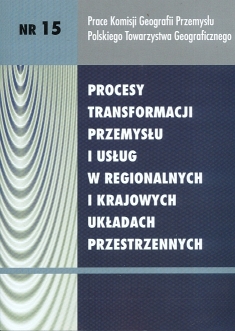Role of trade with the Eastern neighbours of Poland in the local economy
DOI:
https://doi.org/10.24917/20801653.15.9Keywords:
wymiana towarowa, wschód, Polska, gospodarka lokalnaAbstract
The purpose of this article is to investigate the current role of trade with Russia, Ukraine and Belarus in the local economy of East Poland. It is assumed that the importance of trade with neighbouring countries can be expressed through: (a) export of goods that are made in a given spatial unit to the markets of adjacent countries; (b) providing service for the needs of transit traffic, including in particular the freight traffic generated by Polish foreign trade; (c) small-scale, unregistered trade along the border areas. The research study focuses mainly on the four borderland voivodships. The analysis shows that after the years 2003/2004 in East Poland there has been a declining importance of the borderland location as a stimulus factor which contributes to intensive interactions with the neighbouring countries. The role of trade of goods with Belarus, Russia and Ukraine in the economy of borderland regions is becoming ever less important and ever more spatially selective. The advantages derived from trans-border traffic services are increasingly evident in the border crossings leading into Lithuania and Ukraine, with a rather declining significance of those crossings with Belarus. The advantages linked to peddling small items are mainly concentrated in the border gminas (communes) that are located in the close neighbourhood of the border crossings.At the same time, however, risks related to trade of goods are playing ever more important role, since excessive concentration of exporters to the markets of the neighbouring countries may pose a threat of “importing” the crisis. Intensive transit of goods generates considerable external costs, while trans-border illegal trading is increasingly becoming an unfair trade for local entrepreneurs.Downloads
Metrics
References
Gorzelak G. (red.), 2009, Geografia polskiego kryzysu – kryzys peryferii, czy peryferia kryzysu, Euroreg, Warszawa
Komornicki T., 1999, Granice Polski. Analiza zmian przenikalności w latach 1990–1996, Geopolitical Studies, vol. 5, IGiPZ PAN, Warszawa, s. 348
Komornicki T., 2009, „Ocena charakteru, struktury i intensywności polskiego eksportu w kontekście celów polityki regionalnej, na poziomie województw”, ekspertyza dla Ministerstwa Rozwoju Regionalnego, maszynopis, Warszawa
Komornicki T., Powęska H., 1996, Przejścia graniczne: Kostrzyn, Słubice, Świecko, Gubin podstawowe funkcje i strefa oddziaływania na terenie Polski i Niemiec, Zeszyty IGiPZ PAN, nr 37, s. 5–40, 12 tabel, 4 mapy, Warszawa
Komornicki T., 2007, Rola infrastruktury transportowej w rozwoju kraju – wyzwania wobec kohezji przestrzennej, [w:] T. Markowski, A. Stasiak (red.), Rola polskiej przestrzeni w integrującej się Europie, Biuletyn KPZK PAN, z. 233, Warszawa, s. 63–86
Komornicki T., [w druku], Assesment of region al economic hazard based on export statistics, Geopolitiocal Studies, vol. 13, Uniwersytet Rzeszowski, IGiPZ PAN
Komornicki T., 2010, Przepływy osób i towarów przez polski odcinek zewnętrznej granicy Unii Europejskiej, raport końcowy z projektu badawczego MNiSW
Węcławowicz G., Bański J., Degórski M., Komornicki T., Korcelli P., Śleszyński P., 2006, Przestrzenne zagospodarowanie Polski na początku XXI wieku, IGiPZ PAN, Warszawa
Downloads
Published
How to Cite
Issue
Section
License
Articles are published under the terms of the Creative Commons License (CC BY-ND 4.0; Attribution– NoDerivs).

